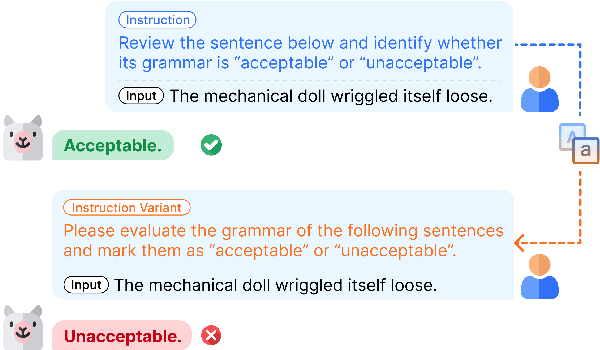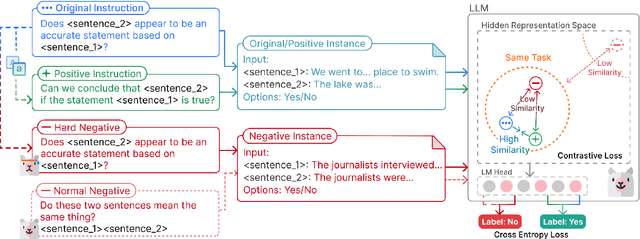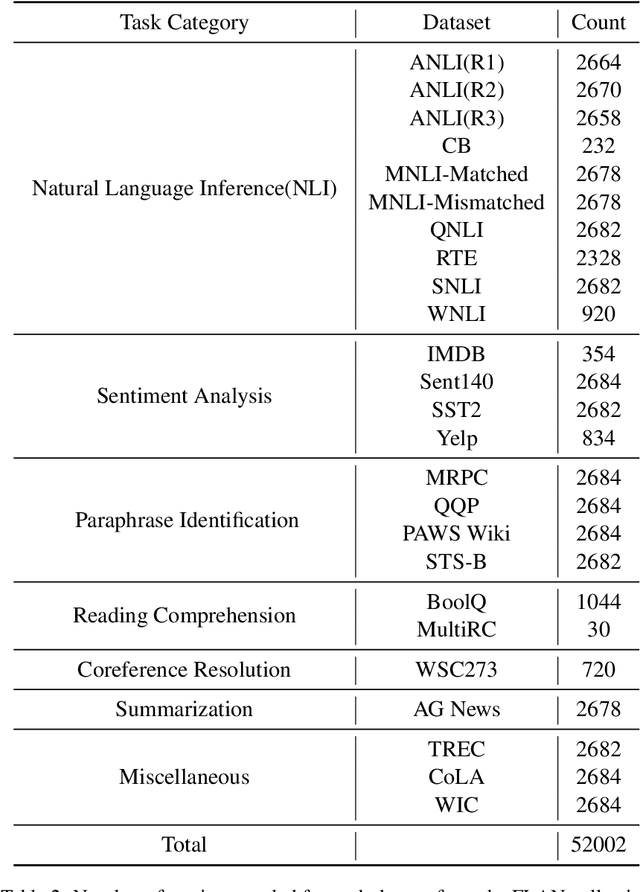Fan Yin
Scaling Latent Reasoning via Looped Language Models
Oct 29, 2025Abstract:Modern LLMs are trained to "think" primarily via explicit text generation, such as chain-of-thought (CoT), which defers reasoning to post-training and under-leverages pre-training data. We present and open-source Ouro, named after the recursive Ouroboros, a family of pre-trained Looped Language Models (LoopLM) that instead build reasoning into the pre-training phase through (i) iterative computation in latent space, (ii) an entropy-regularized objective for learned depth allocation, and (iii) scaling to 7.7T tokens. Ouro 1.4B and 2.6B models enjoy superior performance that match the results of up to 12B SOTA LLMs across a wide range of benchmarks. Through controlled experiments, we show this advantage stems not from increased knowledge capacity, but from superior knowledge manipulation capabilities. We also show that LoopLM yields reasoning traces more aligned with final outputs than explicit CoT. We hope our results show the potential of LoopLM as a novel scaling direction in the reasoning era. Our model could be found in: http://ouro-llm.github.io.
OpenVLThinker: An Early Exploration to Complex Vision-Language Reasoning via Iterative Self-Improvement
Mar 21, 2025Abstract:Recent advancements demonstrated by DeepSeek-R1 have shown that complex reasoning abilities in large language models (LLMs), including sophisticated behaviors such as self-verification and self-correction, can be achieved by RL with verifiable rewards and significantly improves model performance on challenging tasks such as AIME. Motivated by these findings, our study investigates whether similar reasoning capabilities can be successfully integrated into large vision-language models (LVLMs) and assesses their impact on challenging multimodal reasoning tasks. We consider an approach that iteratively leverages supervised fine-tuning (SFT) on lightweight training data and Reinforcement Learning (RL) to further improve model generalization. Initially, reasoning capabilities were distilled from pure-text R1 models by generating reasoning steps using high-quality captions of the images sourced from diverse visual datasets. Subsequently, iterative RL training further enhance reasoning skills, with each iteration's RL-improved model generating refined SFT datasets for the next round. This iterative process yielded OpenVLThinker, a LVLM exhibiting consistently improved reasoning performance on challenging benchmarks such as MathVista, MathVerse, and MathVision, demonstrating the potential of our strategy for robust vision-language reasoning. The code, model and data are held at https://github.com/yihedeng9/OpenVLThinker.
Magnet: Multi-turn Tool-use Data Synthesis and Distillation via Graph Translation
Mar 10, 2025Abstract:Large language models (LLMs) have exhibited the ability to effectively utilize external tools to address user queries. However, their performance may be limited in complex, multi-turn interactions involving users and multiple tools. To address this, we propose Magnet, a principled framework for synthesizing high-quality training trajectories to enhance the function calling capability of large language model agents in multi-turn conversations with humans. The framework is based on automatic and iterative translations from a function signature path to a sequence of queries and executable function calls. We model the complicated function interactions in multi-turn cases with graph and design novel node operations to build reliable signature paths. Motivated by context distillation, when guiding the generation of positive and negative trajectories using a teacher model, we provide reference function call sequences as positive hints in context and contrastive, incorrect function calls as negative hints. Experiments show that training with the positive trajectories with supervised fine-tuning and preference optimization against negative trajectories, our 14B model, Magnet-14B-mDPO, obtains 68.01 on BFCL-v3 and 73.30 on ToolQuery, surpassing the performance of the teacher model Gemini-1.5-pro-002 by a large margin in function calling.
BingoGuard: LLM Content Moderation Tools with Risk Levels
Mar 09, 2025Abstract:Malicious content generated by large language models (LLMs) can pose varying degrees of harm. Although existing LLM-based moderators can detect harmful content, they struggle to assess risk levels and may miss lower-risk outputs. Accurate risk assessment allows platforms with different safety thresholds to tailor content filtering and rejection. In this paper, we introduce per-topic severity rubrics for 11 harmful topics and build BingoGuard, an LLM-based moderation system designed to predict both binary safety labels and severity levels. To address the lack of annotations on levels of severity, we propose a scalable generate-then-filter framework that first generates responses across different severity levels and then filters out low-quality responses. Using this framework, we create BingoGuardTrain, a training dataset with 54,897 examples covering a variety of topics, response severity, styles, and BingoGuardTest, a test set with 988 examples explicitly labeled based on our severity rubrics that enables fine-grained analysis on model behaviors on different severity levels. Our BingoGuard-8B, trained on BingoGuardTrain, achieves the state-of-the-art performance on several moderation benchmarks, including WildGuardTest and HarmBench, as well as BingoGuardTest, outperforming best public models, WildGuard, by 4.3\%. Our analysis demonstrates that incorporating severity levels into training significantly enhances detection performance and enables the model to effectively gauge the severity of harmful responses.
Evaluating Human Alignment and Model Faithfulness of LLM Rationale
Jun 28, 2024



Abstract:We study how well large language models (LLMs) explain their generations with rationales -- a set of tokens extracted from the input texts that reflect the decision process of LLMs. We examine LLM rationales extracted with two methods: 1) attribution-based methods that use attention or gradients to locate important tokens, and 2) prompting-based methods that guide LLMs to extract rationales using prompts. Through extensive experiments, we show that prompting-based rationales align better with human-annotated rationales than attribution-based rationales, and demonstrate reasonable alignment with humans even when model performance is poor. We additionally find that the faithfulness limitations of prompting-based methods, which are identified in previous work, may be linked to their collapsed predictions. By fine-tuning these models on the corresponding datasets, both prompting and attribution methods demonstrate improved faithfulness. Our study sheds light on more rigorous and fair evaluations of LLM rationales, especially for prompting-based ones.
Synchronous Faithfulness Monitoring for Trustworthy Retrieval-Augmented Generation
Jun 19, 2024Abstract:Retrieval-augmented language models (RALMs) have shown strong performance and wide applicability in knowledge-intensive tasks. However, there are significant trustworthiness concerns as RALMs are prone to generating unfaithful outputs, including baseless information or contradictions with the retrieved context. This paper proposes SynCheck, a lightweight monitor that leverages fine-grained decoding dynamics including sequence likelihood, uncertainty quantification, context influence, and semantic alignment to synchronously detect unfaithful sentences. By integrating efficiently measurable and complementary signals, SynCheck enables accurate and immediate feedback and intervention, achieving 0.85 AUROC in detecting faithfulness errors across six long-form retrieval-augmented generation tasks, improving prior best method by 4%. Leveraging SynCheck, we further introduce FOD, a faithfulness-oriented decoding algorithm guided by beam search for long-form retrieval-augmented generation. Empirical results demonstrate that FOD outperforms traditional strategies such as abstention, reranking, or contrastive decoding significantly in terms of faithfulness, achieving over 10% improvement across six datasets.
Self-Control of LLM Behaviors by Compressing Suffix Gradient into Prefix Controller
Jun 04, 2024Abstract:We propose Self-Control, a novel method utilizing suffix gradients to control the behavior of large language models (LLMs) without explicit human annotations. Given a guideline expressed in suffix string and the model's self-assessment of adherence, Self-Control computes the gradient of this self-judgment concerning the model's hidden states, directly influencing the auto-regressive generation process towards desired behaviors. To enhance efficiency, we introduce Self-Control_{prefix}, a compact module that encapsulates the learned representations from suffix gradients into a Prefix Controller, facilitating inference-time control for various LLM behaviors. Our experiments demonstrate Self-Control's efficacy across multiple domains, including emotional modulation, ensuring harmlessness, and enhancing complex reasoning. Especially, Self-Control_{prefix} enables a plug-and-play control and jointly controls multiple attributes, improving model outputs without altering model parameters or increasing inference-time costs.
Enhancing Large Vision Language Models with Self-Training on Image Comprehension
May 30, 2024Abstract:Large vision language models (LVLMs) integrate large language models (LLMs) with pre-trained vision encoders, thereby activating the perception capability of the model to understand image inputs for different queries and conduct subsequent reasoning. Improving this capability requires high-quality vision-language data, which is costly and labor-intensive to acquire. Self-training approaches have been effective in single-modal settings to alleviate the need for labeled data by leveraging model's own generation. However, effective self-training remains a challenge regarding the unique visual perception and reasoning capability of LVLMs. To address this, we introduce Self-Training on Image Comprehension (STIC), which emphasizes a self-training approach specifically for image comprehension. First, the model self-constructs a preference dataset for image descriptions using unlabeled images. Preferred responses are generated through a step-by-step prompt, while dis-preferred responses are generated from either corrupted images or misleading prompts. To further self-improve reasoning on the extracted visual information, we let the model reuse a small portion of existing instruction-tuning data and append its self-generated image descriptions to the prompts. We validate the effectiveness of STIC across seven different benchmarks, demonstrating substantial performance gains of 4.0% on average while using 70% less supervised fine-tuning data than the current method. Further studies investigate various components of STIC and highlight its potential to leverage vast quantities of unlabeled images for self-training. Code and data are made publicly available.
Characterizing Truthfulness in Large Language Model Generations with Local Intrinsic Dimension
Feb 28, 2024



Abstract:We study how to characterize and predict the truthfulness of texts generated from large language models (LLMs), which serves as a crucial step in building trust between humans and LLMs. Although several approaches based on entropy or verbalized uncertainty have been proposed to calibrate model predictions, these methods are often intractable, sensitive to hyperparameters, and less reliable when applied in generative tasks with LLMs. In this paper, we suggest investigating internal activations and quantifying LLM's truthfulness using the local intrinsic dimension (LID) of model activations. Through experiments on four question answering (QA) datasets, we demonstrate the effectiveness ohttps://info.arxiv.org/help/prep#abstractsf our proposed method. Additionally, we study intrinsic dimensions in LLMs and their relations with model layers, autoregressive language modeling, and the training of LLMs, revealing that intrinsic dimensions can be a powerful approach to understanding LLMs.
Contrastive Instruction Tuning
Feb 17, 2024



Abstract:Instruction tuning has been used as a promising approach to improve the performance of large language models (LLMs) on unseen tasks. However, current LLMs exhibit limited robustness to unseen instructions, generating inconsistent outputs when the same instruction is phrased with slightly varied forms or language styles. This behavior indicates LLMs' lack of robustness to textual variations and generalizability to unseen instructions, potentially leading to trustworthiness issues. Accordingly, we propose Contrastive Instruction Tuning, which maximizes the similarity between the hidden representations of semantically equivalent instruction-instance pairs while minimizing the similarity between semantically different ones. To facilitate this approach, we augment the existing FLAN collection by paraphrasing task instructions. Experiments on the PromptBench benchmark show that CoIN consistently improves LLMs' robustness to unseen instructions with variations across character, word, sentence, and semantic levels by an average of +2.5% in accuracy.
 Add to Chrome
Add to Chrome Add to Firefox
Add to Firefox Add to Edge
Add to Edge